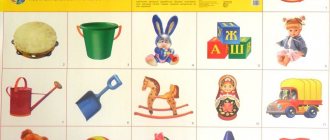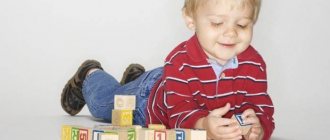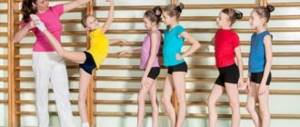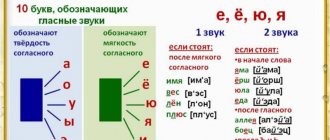- home
- Speech development
Scientists have proven that geniuses are not born, they are made. Becoming a genius in your child is a long and not easy process. The early period of development requires a lot of time, attention, and love. You can’t do without knowledge of techniques. The “Colored Numbers” technique, developed at the beginning of the 20th century by the teacher and scientist from Belgium George Cuisenaire, is a help to all mothers and early childhood educators. His ideas are consistent with the concept of early development, which was put forward by the Russian teacher innovator B.P. Nikitin.
Methodology
What new will the child learn, what skills will the Cuisenaire rods develop in him? Here is a small list of what a child can do thanks to them:
- quickly learn colors;
- will understand the concepts of “short”, “long”, “high”, “low”;
- will develop fine motor skills, thinking, imagination;
- will get an idea of the categories “part”, “whole”, “more”, “less”;
- master construction using a logical approach;
- solve your first mathematical examples, mathematics will become an exciting science.
Description of the kit
Cuisenaire sticks are a set of 116 sticks of different colors and lengths. Total 10 colors: white, pink, blue, red, yellow, purple, black, burgundy, blue, orange.
Each color corresponds to a length. The white stick is the shortest, it is a cube 1 cm long, the orange one is the longest - 10 cm.
The table shows that all colors form three families + white, black (neutral) colors. Orange and purple are present in two families, as they appeared due to the mixing of these colors.
In addition, the numbers encrypted in the red family are divisible by two, in the blue family by three, and in the yellow family by five.
| Red family | Blue family | Yellow family |
| Pink | Blue | Yellow |
| Red | Blue | Orange |
| Burgundy | Violet | |
| Orange | ||
| Violet |
In addition to the Cuisenaire counting sticks themselves, the set contains mathematical signs for basic operations, as well as numbers from 1 to 20. For children who have already mastered “color counting”, classic examples can be used, like at school. Also included are instructions for use.
The material used for the “color count” is lightweight, smooth, and made from certified plastic. They are excellent counting material. Cardboard numbers and signs. This workbook helps you do addition, subtraction, multiplication, and division.
Making your own counting sticks
The set contains parallelepipeds ranging in size from 10 to 1 cm; they differ in color and material from which they are made. There are also instructions for colored Cuisenaire counting sticks, templates for different numbers and a manual with recommendations and a list of steps, tasks and examples. The lengths of the bars indicate numbers, and the colors indicate their classes.
The longer the stick, the larger the number; each centimeter adds one. Groups and classes are divided by shade: red - numbers that are multiples of two, green and blue are divided by three, units are indicated by white, and divisible by 5 and 10 - orange and yellow. The classic collection contains 241 sticks, but for preschoolers they produce simplified sets of 119 or 144 blocks. In some models, green is replaced by blue or purple, and red by pink.
Parents do not have to purchase a ready-made set; they can make it themselves. Sticks are made from wooden blocks or colored cardboard. The first option will allow the child to navigate not only by the shades and length of the product, but also by its volume. On the Internet you can find a table of the sizes of each block, as well as stencils and templates. They are printed and used to cut out sticks from the selected material. Wooden sticks are coated with a layer of acrylic paint in a tone corresponding to the class of numbers.
It is advisable to write numbers on cardboard products, so children will remember them faster. If classes are conducted using a magnetic board, then small magnets are also attached to the back of the blocks. Pre-prepare a box for storage. It should have different sections for each color of stick. After lessons, the child will independently arrange the blocks into the appropriate cells. This will help develop self-discipline and teach your child order.
Purposes of use
There are parents who are afraid that it is too early to load their child with mathematics. Educators agree that it is better to worry about it not being too late. Sensitive periods in development do not last so long; we cannot know for sure about their timing. They pass very quickly; will the child have time to master the necessary skill during this period? Therefore, it is better to offer your child tasks in his zone of proximal development. It may be difficult for now, but when his brain is ready, he will cope with the task, to the surprise of you and those around him.
Here are the main reasons why teachers all over the world actively use Cuisenaire colored counting sticks in their teaching practice:
- Using the clarity of mathematical operations, which allows you to work with young children.
- Development of fantasy and imagination. The number of tasks with this tool tends to infinity.
- Fine motor skills develop, as the fingers are involved in the work.
- Science turns into an exciting game, which means it is easier for children to perceive and assimilate. Oral counting is easy.
- Helps in developing related skills and teaching writing. You can build with them like a construction set, lay out words, and assemble labyrinths.
- Allows you to measure the lengths of other objects, since the length of each color module in centimeters is known in advance.
- Makes it possible to consolidate the understanding of geometric shapes by drawing up their contours.
- Forms a sustainable interest in knowledge, including mathematical science.
What are Cuisenaire's wands?
This manual gets its name from the Belgian educator who created it. George Cuisenaire developed special blocks that help master the laws of mathematics. The game material has a second name - “numbers in color”. The cuisenaire set includes canes of 10 different colors and sizes from a centimeter to ten. The set is a complex mathematical set.
Description of the technique
The Cuisenaire set is used to develop a child’s interest in mathematics in a playful way at home, this is the main goal. Logic games with it will appeal to inquisitive kids. Teaching mathematics in a playful way with the Cuisenaire set is based on the principle of clarity. If a child sees an object and can even touch it, it will be much easier for him to understand the science of counting. It will also be easier for parents to explain mathematics to their children with the help of visual teaching aids. Characteristics of Cuisenaire's rods that a child remembers and distinguishes:
- color;
- concept of numerical value;
- length.
What can you teach a child
The main purpose of the Cuisenaire set is to help the child become familiar with mathematics. However, with its help, the baby will be able to learn much more. He will be able to learn:
- compose colored numbers and letters, while matching symbols with concepts;
- distinguish how objects are located in space (in front and behind, right and left, between, middle, below and above);
- mathematical concepts (number, figure, figure, more and less, equally, etc.);
- basic math skills: addition and subtraction;
- disassemble numbers into components;
- understand what quantity is, how numbers and figures relate;
- determine the previous and next numbers for the current one within the first ten.
From what age
Cuisenaire sticks, as well as Dienesh blocks, can be used even earlier than indicated on the box. The author himself suggested starting classes from 1 year. Experienced teachers recommend starting classes at the age of 2, under the mandatory supervision of parents. In fact, without their participation, the educational and gaming process will not work. As the child grows up, gaming tasks become more complex.
The largest number of tasks is provided for ages 3–4 years. Middle age, preschoolers (5-6 years old) are capable of solving more serious educational problems. Even older children, primary school students (7-9 years old) find these activities interesting.
Educational games and activities with cuiseneur sticks
The teaching method is suitable for a child of any age. Preschoolers will have a lot of fun playing with the set; older children will find it useful as a math teaching tool. Parents are offered a huge amount of materials, which present ready-made games, scenarios, and example tasks. All this makes it much easier to plan and conduct classes with inquisitive children. What can you do with the benefit (in stages, depending on age) using the Cuisenaire method:
- Play. The child lays them out and sorts them out.
- Compare as analogues of numbers. If you indicate the difference between them, the child will clearly understand the difference between “more” and “less”.
- Post the numbers.
- Explain the principles of addition and subtraction.
- Lay out in mosaics, recognizing their numerical relationships and meanings.
- Summarizing the essence of arithmetic operations. Gradually, you will develop your baby's mathematical abilities.
Introduction to chopsticks for little ones
At first, the baby will simply play with the counting material, like with cubes. Then offer to play “Find Me.” Give your child the following tasks in any order:
- list the colors of all the bars;
- find the one that is longer than the red one and shorter than the blue one;
- find all the bars of the same shade;
- lay out strips of two colors, alternating red and blue;
- find a block that is NOT yellow;
- choose two strips and compare their length;
- find the shortest one and name the color;
- select one of each shade.
Help your child draw some conclusions. He should emphasize that stripes of the same color are equal in size. To do this, take a couple of any bars and ask your child questions:
- Are these sticks different?
- What is the same about them?
- What's different?
Games with Cuisenaire sticks
There are many fun activities with blocks. You can purchase special materials with examples or even come up with games yourself. A few simple options:
- “Take a guess.” Hide one block. The child guesses what color it is by asking “yes” and “no” questions. For example, “Is the missing stick shorter than the yellow one?”, “Is it longer than the black one?”
- “Make a picture.” The kid, using the set as a constructor, puts together certain images, starting with the simplest ones and then increasing the complexity: square, triangle, fence, house, Christmas tree, etc.
Studying the color scheme
This is the first characteristic that a child should be introduced to. You can do this using the following games:
- "Train". Let the child imagine that the cuisinaire's sticks are trailers. Ask your child to fold the colored striped “train” so that the orange “car” is to the left of the burgundy one, but to the right of the red one.
- Dictation. Name the colors to the baby, and he takes out the corresponding bars from the general pile and lays them out from left to right.
Counting sticks
This stage of training is the most extensive. First you need to introduce your child to the sequence of natural numbers. Build horizontal, vertical, symmetrical ladders. The child will understand the basic law of the natural series: each number is one more than the previous one and less than the next one. Then you can begin to master direct and reverse counting using the same ladders as an example. Task options:
- Give your child the third and fourth stripes (blue and red). Have him determine the larger number and check if it is correct by measuring the length of both with a white cube.
- Move on to simple arithmetic. First, use an example to show that if you put a red block, and next to it a blue block with a white block, you will get segments of the same length (4 = 3 + 1). Gradually make the tasks more difficult. This will help you master addition. Then add examples in which one of the two sticks disappeared. These will be subtraction examples.
- Learn to multiply. Place one white stick in front of the baby, the child will voice its meaning “one”. Add a second one, ask how much you get. Gradually you will master multiplication by two, showing longer and longer stripes.
- Lay out 4 white cubes to make a square. Introduce your child to fractions and fractions. Ask him which part is larger: a quarter or a half.
Measurement-Based Jobs
This is a very important stage of training. Examples of measurement tasks that you can set for your child:
- Hide the red stripe. Tell your child that the one you hid is longer than the blue one, but shorter than the orange one. He will try to guess which one is hidden.
- Use different sticks to measure small objects in the playroom. Let the baby find things equal to the length of, for example, an orange block.
- Build a path, skipping sections of different sizes. The child will fill them with suitable pieces.
- Compare objects and bars several at a time, working through the concepts of “more”, “less”, “shorter”, “longer”.
Determine the composition of the number
Invite your child to make a train out of colored sticks, for example, pink, blue, red, yellow. These are carriages. Before seating passengers on the train, let the child name how many seats there are in each of them. This must be done in a practical way. The kid places white sticks on the carriages. One piece - one place. This work will lead to the understanding that each number consists of several ones.
Logic problems
A good option is “Riddles”. Model the situation for your child: a train consists of three cars. Yellow is in the middle. The pink trailer is not the first one in the lineup. The kid will try to figure out in what order to arrange the sticks in order to meet the conditions of this statement. As you go, complicate the logic block game task by asking additional questions:
- How many passengers are there in each carriage?
- Total on the train?
- There are three carriages. Together they are the same length as the orange stick. What are their colors?
- There are three identical carriages. They correspond in length to the blue and blue sticks. What color are they?
Advantages and disadvantages
There are many positive aspects, below are some of them:
- There are many options on how to develop fine motor skills, thinking, and imagination;
- Formation of conscious attention, perseverance;
- Memory training, reactions;
- The ability to use one teaching material for children of different age groups, changing only the wording of the tasks themselves;
- Children acquire the skill of finding solutions independently.
Scientists could not find any disadvantages as such. Some sources indicate that the disadvantage is the need for the presence of an adult, since when playing independently, children quickly lose interest in such a game. We can say that all upbringing and training requires the participation of adults, so this minus should not be taken into account.
To achieve maximum results, you need to work with your child systematically. Proper encouragement and a variety of activities will also help in quickly mastering the basics of mathematics.
Similarities and differences with Dienes blocks
Often, Cuisenaire sticks and Dienesh blocks stand side by side among early development techniques. This is no coincidence; they are somewhat similar. Both methods use visual and effective material, train logical thinking, and develop imagination. They are multifunctional, aimed at children of different ages, and easy to learn.
The difference between Dienesh blocks is the additional parameter of differences in materials in thickness (thin and thick) and in shape (circle, triangle, square). In Cuisenaire's colored rods there is a difference in length in centimeters, as well as a larger number of colors. They have the opportunity to create examples from numbers using mathematical symbols, illustrating them with examples of “color counting”.
Dienesh blocks and Cuisenaire sticks are techniques that represent demonstration material; they do not contradict each other, but complement each other perfectly. You can use these two sets together. This will allow you to further diversify your classes by coming up with new and interesting tasks. An innovative approach to education calls for teaching through play so that information is remembered easily and naturally.
Preschool preparation
Children aged 5-6 years old need to be prepared for school. This is best done with the help of educational games. All tasks must be appropriate to the child’s age and intellectual abilities. It is recommended to conduct the following classes:
- select all blocks whose length is less than the maximum and greater than the minimum stick;
- measure the dimensions of one block by others;
- add any figure or number in different ways;
- teach the child to exchange products with different meanings;
- measure using blocks of books, notebooks and boxes of pencils or paints;
- make blocks of numbers from 10 to 20;
- parents assemble a flat figure from products, and the child must repeat it.
For fun after class, you can play with sticks. Three-dimensional figures are created from them. You need to start with simple designs. A child can build a labyrinth, a small well or a bird house, assemble a car or an animal. To make the lesson interesting, children are read a riddle. They should not pronounce the answer, but lay it out from the blocks. You can also purchase a special album in which kids will draw illustrations for different fairy tales in blocks. The completed book is kept so that in the future the grown-up child will be able to look at the creativity of his childhood.
Parents who worked with their children using the Cuisenaire method with colored sticks and blocks noted that the children developed faster, they had a desire to attend school and study. The game form of classes instills in the child an interest in lessons and learning new things.
The assignments will help parents quickly and efficiently prepare their preschoolers for mathematics, the Russian language, and creative subjects. Children take part in group and individual lessons with pleasure, classify sticks according to various characteristics and criteria, and create flat and three-dimensional figures from them. Try Cuisenaire sticks too, because the description of the methodology offered on our website gave a complete picture of counting exercises.
Games
For children in kindergarten, preschoolers and schoolchildren, various games with Cuisenaire sticks have been developed, from the simplest to the more complex.
Games for kids 1 – 2 years old
Children can only work with this manual under adult supervision, as there are small parts. Home comfort and familiar surroundings contribute to the development of new activities. Already at one year old, children can play with them, look at colors, and the adult’s task is to give comments about length, color, height, quantity.
"Builder". Invite your child to look at the building materials, take as many blocks as possible in one hand, then transfer them to the other. So the child's hand will begin to feel the difference in size and quantity. Build a road, house, bridge, tree, well, transport with your child.
"Sorter." You can take colored cardboard and invite your child to sort the sticks by color. You need to put all the red ones on the red sheet, and all the yellow ones on the yellow sheet.
"Up the stairs." Assemble the ladder from the white to the yellow stick. Take a small toy, such as a bunny, and let him jump up the stairs. At the same time, count “The bunny jumps again, one, two, three, four, five.” Then you can assemble a ladder higher, and count to 10. When the child has mastered this game, you can skip the steps (the ladder is broken) so that the child puts them in place (repairs the ladder).
"Do as I do". Show the child a blue stick in your hand and ask him to take the same one. Take two sticks and have him repeat. Make the roof of the house out of them. The essence of the game is that the child learns to correlate what you show and do the same. You can hum a song before each new demonstration and repetition, “trawl-la-la, trawl-la-la, do Mishenka (your child’s name) like me!” You can use the mirror method on paper. An image is drawn on one half, and the child must complete the second half using a template.
"Colored fence" Lay out two colored sticks, then again two of the same. Say that you are painting the fence blue and orange, and invite your child to continue the fence. Then you can complicate it by adding a number of colors, building more complex sequences. For example, blue, white, pink, yellow. Let the child post more.
"Elusive." Play with the sticks as if they were living characters, say that now they will run away, change places, hide. Lay out five sticks, and then, while playing with them, hide one behind your back or next to the box. Ask your child which stick disappeared? Where did she go? Let him find her. You can also swap them, red was the first. Place it in the middle. Where did she go? This game develops attentiveness and trains memory.
"Train". Build a train with carriages of different lengths using sticks. Name colors and sizes. Ask which carriage is the longest, what does it carry? Maybe logs for the house. What is the smallest carriage that can carry? Maybe apples. How many cars are there at the station? How many have gone, how many are left? During this game, the child learns the concepts of “long”, “short”, “big”, “small”, “one”, “many”. To complicate the game, you can ask which car is to the right of the red one, to the left of the yellow one.
Tasks for children 3 – 4 years old
Older children at 3-4 years old can already learn simple counting and repeat games from the previous stage, but with a little more complexity. This is important at the stage of entering kindergarten, because there they also give educational tasks, and perseverance is required. Here are some new games that can be offered at this age.
"Figure Outline" . Draw geometric shapes on paper or print them out, ask your child to draw its outline with sticks and name the shape. Show yourself how to lay out a square, triangle, rhombus. You can also make labyrinths out of them. The resulting path can be completed with the help of small toys and cars.
"The Stick Story" First, lay out the story yourself with chopsticks, then ask your child to do it. Lay out a long stick (dad decided to build a house, made a foundation), put two perpendicularly along the edges (put walls), on top two more at an angle upward (made a roof). It turned out to be a great house, but without windows and doors. Make a window and a door from small blocks. This task develops oral speech very well. Make sure that the logic of presentation is followed.
"Guess which one . Hide the stick in your fist and say that you are holding the one that is larger than pink but smaller than red. What stick is in your fist? Blue, that's right! Keep playing by asking questions like these.
“Color with sticks . You can purchase ready-made albums, or print out drawing diagrams yourself in order to color them with sticks. For example, you printed a hare. Let the child choose the appropriate length elements for the ears, paws, and tail. And you say the ears are long, the tail is short. You can also recite a poem with the theme of the picture “A bunny jumped on the lawn, a long-eared, colored bunny.” You must show the algorithm of actions so that the child can repeat it.
Tasks for children 5 – 6 years old
Preschool age 5–6 years is optimal for introducing new tasks, as active preparation for school is underway. Tasks should lie in the zone of proximal development. Study the Federal State Educational Standard (federal state educational standard), see what skills a child should have, and practice in the game those skills that will be useful in elementary school.
"Who is faster" . You name the number, the preschooler must pick up the stick that corresponds to this number faster than you. Also, on the contrary, you take a stick, raise it up, and his task is to quickly say the number that corresponds to it.
"Exceptions" . We offer a set of tasks for exceptions, for example, “Give me one that is neither blue nor red,” “give me a stick shorter than the burgundy one, but longer than the pink one,” “choose two sticks that will not make the same length as the yellow one.” There are many options for such exception tasks. We recommend that you first make a list for yourself and write down the correct answers on paper so that you don’t get confused later.
"Simple Examples" . Show that two white sticks form one pink one. And pink and white are equal to blue. You can label the numbers on the sticks to start making associations between writing the numbers and the color/size. Let’s do problems like this: “how many white sticks must be added to the blue one to make blue?”
"With eyes closed" . Set the condition to determine the color of the stick, using only your fingers, with your eyes closed. Explain that the smallest stick is 1 cm, about the width of a finger. Teach your child to measure the distance of sticks using their fingers. You can hang a bell and ring it as many times as the number of the pulled out stick corresponds to.
Tasks for children 7 – 9 years old
The school continues to improve the skills acquired earlier. At the age of 6–7 years, discipline appears and the student’s readiness to solve more complex problems that require more attention and perseverance. It’s good when tasks overlap with the school curriculum during this period or even slightly overtake it.
"Part and Whole" . A lesson on fractions can be fun. Put down an orange stick and say that it is whole, but consists of two parts (put two yellow sticks). Just like 10 consists of 5 and another 5. Five is ½ of ten, which means half. Place sticks of the same length in front of you and the child. For speed, find two other sticks so that together they are the same length as the first. For example, nine can be made in several ways from two and seven, from one and eight, from five and four, from three and six.
"Make a number" . Offer the student the following exercise on number composition. There are ten sticks, but you can add any number from them. Orange and white are eleven. Two orange is twenty. Show your child this pattern, let him make up 15, 22 and other numbers.
“Solve an example . Use cardboard numbers and signs to lay out an example. The child’s task is to use sticks to show a visual solution to this example. Let's say you put 2+3 = The child must put pink, blue and yellow sticks. Then give an oral report on why he chose these particular colors.
Games for 4-5 years old
From the age of four, mathematical problems are added. Lessons become more meaningful and goals become more specific. Examples of tasks:
- move two white sticks together and ask the child to find one that is equal in length to the line formed;
- call the numbers out loud in order, and the baby says the corresponding color;
- The student must find blocks with numbers and lay them out in ascending or descending order.
It is advisable to use cardboard colored cards with numbers for training. Their shade should match the blocks. With their help, children will learn to correlate sizes and colors with visual images.
At the age of five, a child should be engaged in full-fledged mathematical problems. The adult asks questions, and the child must answer them by showing the appropriate sticks. Ask children about the difference in block lengths. Then begin exercises on multiplying and dividing numbers. At this time, use classic problems with fruits and vegetables.
In addition to mathematical operations, the Cuisenaire method for preschoolers allows you to learn languages:
- place emphasis with chopsticks on sheets of paper with printed words;
- build a rhythmic scheme of sentences - use sticks to indicate punctuation marks;
- using letter cubes to divide words into syllables;
- They do a syntactic analysis of the sentence, using colors to indicate different members - subject and predicate, object and participial phrases.








